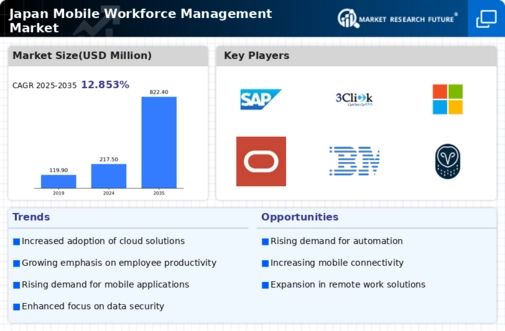Rising Demand for Remote Work Solutions
The mobile workforce-management market is significantly influenced by the rising demand for remote work solutions in Japan. As organizations seek to enhance flexibility and productivity, mobile workforce-management tools are becoming essential. A recent survey indicates that over 60% of companies in Japan are investing in mobile solutions to support remote work. This trend is likely to continue, as businesses recognize the benefits of enabling employees to work from various locations. The mobile workforce-management market is projected to expand as companies prioritize tools that facilitate collaboration and communication among remote teams. This shift not only improves employee satisfaction but also enhances overall operational efficiency.
Technological Advancements in Mobile Solutions
The mobile workforce-management market in Japan is experiencing a surge due to rapid technological advancements. Innovations in mobile applications and devices are enhancing the efficiency of workforce management. For instance, the integration of advanced GPS tracking and real-time data analytics is enabling organizations to optimize their operations. As of 2025, it is estimated that the mobile workforce-management market will grow by approximately 15% annually, driven by these technological improvements. Companies are increasingly adopting mobile solutions to streamline communication and task management, which is crucial in a competitive landscape. This trend indicates a shift towards more agile and responsive workforce strategies, allowing businesses to adapt quickly to changing market demands.
Increased Focus on Data Security and Compliance
In the context of the mobile workforce-management market, the heightened focus on data security and compliance is becoming increasingly critical. As organizations in Japan adopt mobile solutions, they must also address the challenges associated with data protection. The implementation of stringent data privacy regulations is compelling companies to invest in secure mobile workforce-management tools. A recent report suggests that approximately 70% of businesses are prioritizing security features in their mobile applications. This trend indicates a growing awareness of the importance of safeguarding sensitive information, which is likely to drive the demand for advanced security solutions within the mobile workforce-management market.
Evolving Workforce Demographics and Expectations
The mobile workforce-management market is also being shaped by evolving workforce demographics and expectations in Japan. As younger generations enter the workforce, there is a noticeable shift in preferences towards flexible working arrangements and technology-driven solutions. This demographic change is prompting organizations to adapt their workforce management strategies to meet the expectations of a more tech-savvy workforce. It is estimated that by 2025, nearly 50% of the workforce will consist of millennials and Gen Z, who prioritize mobile accessibility and user-friendly interfaces. Consequently, the mobile workforce-management market is likely to see increased demand for solutions that cater to these evolving needs, fostering a more engaged and productive workforce.
Government Initiatives Supporting Digital Transformation
Government initiatives in Japan aimed at promoting digital transformation are playing a pivotal role in the mobile workforce-management market. Policies encouraging the adoption of digital technologies are fostering an environment conducive to innovation. For example, the Japanese government has set ambitious targets for increasing the use of digital tools across various sectors. This support is likely to drive investments in mobile workforce-management solutions, as organizations seek to comply with new regulations and leverage available incentives. The mobile workforce-management market is expected to benefit from these initiatives, with an anticipated growth rate of around 12% over the next few years, as businesses align their strategies with government objectives.

















Leave a Comment